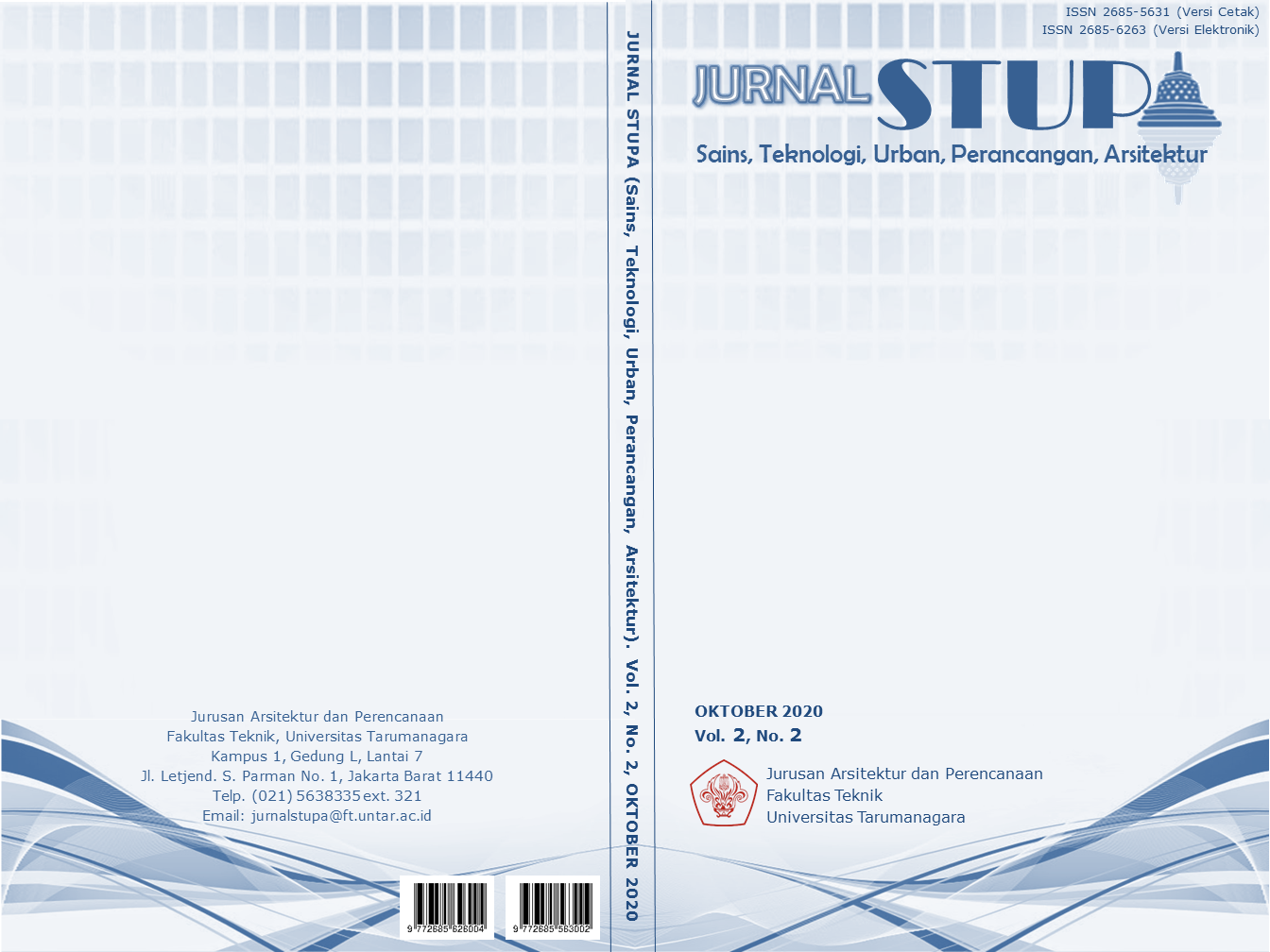PENERAPAN METODE DIAGRAM SEBAGAI BAHASA PADA TRANSFORMASI GUBAHAN MASSA RUANG SOSIAL INTERKULTURAL SEBAGAI TEMPAT KETIGA DI KELURAHAN SELONG
Main Article Content
Abstract
Intercultural Social Space is a space that designed in response to the social distance that occurs in the Selong Village, Kebayoran Baru, South Jakarta. It's located on Senopati street. Demographically, this site divides the dominance of function and figures within the area. This increasing the social distance between the neighborhood and the character of the people who have the cultural diversity. So, this needs a space as a dwelling in the area. So that, it increase relations and social interactions activities between neighborhood in the Selong Village. This project was designed for a space that facilitate the ongoing social interaction activities between neighborhood in the Selong Village. Performing arts is used as a program, whether it's for learning or for watching theatre , dance or music performances. Which, indirectly will bring up the method of trialogical learning of interactions that occur between figures in the Intercultural Social Space. The performing arts program was appointed as a concept of shape transformation. Specifically, the ballet that is used as a medium for the formation of mass compositions. This because, dance in the design project program is the basis of the performing arts, namely motion. Ballet used as a form of medium shape transformation because ballet is a dance that influences other dances globally and it's related to intercultural issues. The motion in the dance is translated into Laban notation, then it's deconstructed, superimposed, and it's adjusted with the program, to get a mass composition that has a suitability of sturdiness, and the success of the building in fulfilling the function of it's activities, as well as it's aesthetics. Therefore, the diagram method is used to facilitate the delivery of information from the elaboration of the shape transformation process that occurs in the Intercultural Social Space project as a third place in Selong Village.
Keywords: dance; demographic; diagram; dwelling; neighborhood
Ruang Sosial Interkultural merupakan suatu wadah yang dirancang sebagai respon dari adanya jarak sosial yang terjadi di Kelurahan Selong, Kebayoran Baru, Jakarta Selatan. Lokasi tapak perancangan berada di jalan Senopati. Secara demografis, jalan ini “membagi” dominasi fungsi dan figur di dalam kawasan tersebut. Hal ini membuat jarak sosial yang semakin meningkat antar neighborhood dengan karakter masyarakat yang memiliki keberagaman budaya. Sehingga, diperlukannya suatu wadah sebagai dwelling pada kawasan tersebut. Agar, meningkatnya relasi dan kegiatan interaksi sosial antar neighborhood di Kelurahan Selong. Proyek ini dirancang sebagai wadah yang memudahkan berlangsungnya kegiatan interaksi sosial antar neighborhood di Kelurahan Selong. Media seni pertunjukan digunakan sebagai program, baik itu pembelajaran maupun menyaksikan pertunjukan teater, tari maupun musik. Dimana, secara tidak langsung akan memunculkan metode pembelajaran trialogis dari interaksi yang terjadi antar figur di dalam Ruang Sosial Interkultural. Program seni pertunjukan diangkat sebagai konsep transformasi bentuk. Yaitu, tarian balet yang digunakan sebagai media pembentukan komposisi massa. Hal ini dikarenakan, tarian dalam program proyek perancangan menjadi dasar dari program seni pertunjukan, yaitu gerak. Tarian balet digunakan sebagai media transformasi bentuk dikarenakan balet menjadi tari yang berpengaruh pada tarian lain secara global dan kaitannya dengan isu interkultural. Gerak dalam tarian diterjemahkan kedalam notasi laban, kemudian dilakukan dekonstruksi, superimposisi, dan penyesuaian dengan program, hingga mendapatkan komposisi massa yang memiliki kesesuaian kekokohan, keberhasilan bangunan dalam memenuhi fungsi kegiatannya, serta aspek keindahannya. Oleh karena itu, metode diagram digunakan untuk mempermudah penyampaian informasi dari proses transformasi bentuk yang terjadi pada proyek Ruang Sosial Interkultural sebagi tempat ketiga di Kelurahan Selong.
Article Details
References
Barnett, V. (2009). Sample Survey Principles and Methods. John Wiley & Sons.
Bennet, W. J. (1984). Intercultural Communication Training in Cultural Self-awareness for study abroad. Minneapolis: Unpublished doctoral dissertation.
De Chiara, J. (1984). Time Saver Standards For Residential Development. New York: Mc Graw – Hill Book Company.
Dondis, D. A. (1974). A Primer of Visual Literacy. New York: MIT Press.
Gallion, A. B. (1992). Pengantar Perancangan Kota. Jakarta: Erlangga.
Gibberd, F. (1970). Town Design. London: Architectural Press.
Graham, L. (2003). North Town. New York: Boyds Mills Press.
Hakkarainen, K. (2009). A knowledge-practice perspective. Springer.
Jane, J. (1961). The Death and Life of Great American Cities. New York: Vintage.
Jormakka, K. (2003). Basic Design Methods. Birkhäuser Architecture.
Larrice, Michael, Macdonald, & Elizabeth. (2007). The Urban Design Reader. New York: Routledge.
Madanipour, A. (2003). Public and Private Spaces of the City. New York: Psychology Press.
Oldenburg, R. (1999). The Great Good Place. New York: Marlowe & Company.
Pena, W. M., & Parshall, S. A. (2001). Problem Seeking: An Architectural Programming Primer. New York: John Wiley & Sons, Inc.
Widasari, P. (2009). Perubahan Fungsi Hunian dan Pengaruhnya Terhadap Kualitas Ruang Kota. 2009: Universitas Indonesia.
Zenner, E., Backus, A., & Winter-Froemel, E. (2018). Cognitive Contact Linguistics: Placing Usage, Meaning and Mind at the Core of Contact-Induced Variation and Change. Berlin: De Gruyter Mouton.


